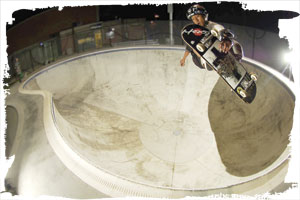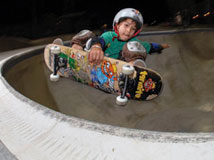 When Heidi Lemmon started the Skate Park Association of the United States in 1996, there were no public skate parks in San Diego County. Thirteen years later, local skaters have more than 20 public or private skate parks—varying in size, features and difficulty—to choose from within the County.
When Heidi Lemmon started the Skate Park Association of the United States in 1996, there were no public skate parks in San Diego County. Thirteen years later, local skaters have more than 20 public or private skate parks—varying in size, features and difficulty—to choose from within the County.
“The San Diego area is known for having a lot of skate parks and family parks,” says Lemmon, executive director of the Venice-based association. “But there never seem to be enough.”
Lemmon says the majority of public skate parks are free; private parks typically charge a daily fee or offer annual passes.
SoCalSkateparks.com lists seven parks that “meet the needs of all skateboarders at all levels,” seven designed for “levels of skateboarding from beginner to advanced” and four ideal “for a beginner to learn the basics.”
The quality and variety of parks is evident when eyeing SoCalSkateparks.com’s list of the top 20 parks within Southern California. Of the top 20 parks for the advanced skater, five are within San Diego County:
Mission Valley YMCA Krause Family Skate Park, Pala Skate Park; San Diego-Washington Street Skate Park; YMCA Magdalena Ecke and Poway Skate Park.
Known for having more than 53,000 square feet of park, the Mission Valley YMCA Krause Family Skate Park in Clairemont (for advanced skaters) features an X-Games-style vert ramp and 40,000 square feet of skate terrain. Its concrete “pool” is considered one of the best.
The 37,000-square-foot YMCA Magdalena Ecke park in Encinitas is home to the 2003 X-Games vert ramp, one of the largest vert ramps built to date. Of the parks that cater to beginner or intermediate skaters looking to improve their skills, two are in Oceanside. The 8,000-square-foot Melba Bishop and 6,000-square-foot Martin Luther King Jr. skate parks, which both opened this year, are smaller than typical parks. The Melba Bishop park’s design has a flow feel with small bowls, while the MLK Jr. park has a street design with ramps, rails and stairs.
Of the parks that cater to beginner or intermediate skaters looking to improve their skills, two are in Oceanside. The 8,000-square-foot Melba Bishop and 6,000-square-foot Martin Luther King Jr. skate parks, which both opened this year, are smaller than typical parks. The Melba Bishop park’s design has a flow feel with small bowls, while the MLK Jr. park has a street design with ramps, rails and stairs.
An example of a beginner’s park is the La Mesa YMCA park, which is similar to the two Oceanside parks in size and features a street layout with smaller ramps and stairs.
Lemmon says that a child’s age is not always telling of his skill level, and that it’s up to the skater and his parents to determine which skate parks are appropriate. “The younger the kids are, the faster they learn. It’s incredible the stuff [they] can do.”
Safety
The majority of public parks are unsupervised, which may cause concern among parents with younger skaters. As of January 2009, the city of San Diego eliminated skate park supervisors as well as park entrance fees at all five of the city-owned parks. Other local government agencies that do not supervise their parks include Chula Vista, Poway, Santee, Carlsbad and Oceanside. However, Lemmon says skate parks operate fine when unsupervised as parents tend to watch their children skate if they are beginners or younger than the majority of skaters at a particular park. According to the U.S. Consumer Product Safety Commission, approximately 26,000 people need hospital emergency room treatment each year for injuries related to skateboarding, with fractures being the most frequent type of injury. Of those injured each year, one third are skateboarders who have been skating for less than a week.
According to the U.S. Consumer Product Safety Commission, approximately 26,000 people need hospital emergency room treatment each year for injuries related to skateboarding, with fractures being the most frequent type of injury. Of those injured each year, one third are skateboarders who have been skating for less than a week.
The National Safety Council says skaters should wear protective equipment at all times. It might not fully protect skateboarders from fractures, but can reduce the number and severity of cuts and scrapes. Other safety suggestions include: When purchasing a helmet make sure it fits properly, meaning the helmet does not block vision; make sure padding worn is not loose-fitting or too tight; and give your board a safety check prior to riding.
Erik Pisor is a San Diego-based freelance writer. Photos provided by the Skate Park Association.
For more articles select the "Next" button below.